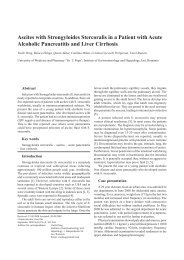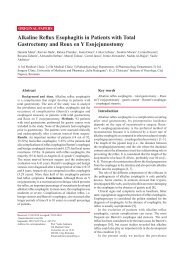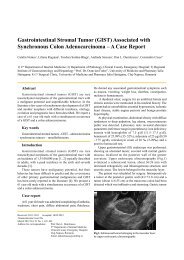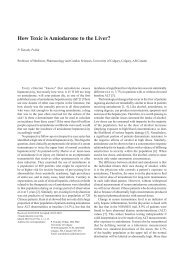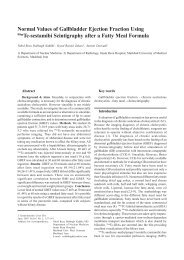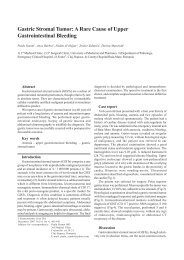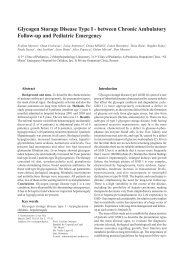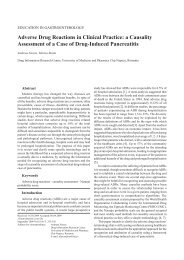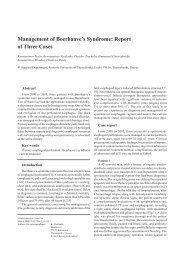download Full Article (PDF file) - Journal of Gastrointestinal and ...
download Full Article (PDF file) - Journal of Gastrointestinal and ...
download Full Article (PDF file) - Journal of Gastrointestinal and ...
You also want an ePaper? Increase the reach of your titles
YUMPU automatically turns print PDFs into web optimized ePapers that Google loves.
Irritable bowel syndrome <strong>and</strong> spasmolytics 21<br />
Table VII. Rectal motility parameters in IBS patients<br />
Motility Parameters<br />
Motor Activity<br />
(as a % <strong>of</strong> total time)<br />
(normal: 75.6±4.7)<br />
Motor Quiescence<br />
(as a % <strong>of</strong> total time)<br />
(normal: 24.46±4.7)<br />
Intraluminal pressure<br />
(cm H 2<br />
O)<br />
(normal: 25-30)<br />
Motility index<br />
(normal: 8,5)<br />
Type <strong>of</strong> IBS Before After Before After Before After Before After<br />
IBS with predominant constipation (n= 36) 75.3±6.2 75.4±8.2 24.7±4.3 26.4±4.8 58.4±0.57 47.3±5.6 5.7±3.1 5.9±2.8<br />
IBS with predominant diarrhea (n= 21) 70.5±6.8 70.2±4.3 24.4±5.8 24.5±4.3 56.4±0.44 48.4±5.9 5.9±2.2 6.8±2.2<br />
IBS with predominant pain <strong>and</strong> bloating (n= 39) 75.4±5.2 72.6±2.3 26.8±4.4 22.±4.0 52.8±0.55 48.6±4.6 5.2±2.4 5.8±2.6<br />
Table VIII. Sigmoid motility parameters in IBS patients<br />
Motility parameters Time <strong>of</strong> activity (%)<br />
normal: (85.8±2.2)<br />
Time <strong>of</strong> rest (%)<br />
(normal: 14.2±2.2)<br />
Intraluminal pressure<br />
(cm H 2<br />
O)<br />
(normal: 30-40)<br />
Activity index<br />
normal: 12,5)<br />
Type <strong>of</strong> IBS Before After Before After Before After Before After<br />
IBS with predominant constipation (n= 36) 67.3±4.2 69.6±5.2 35.2±4.2 32.4±4.4 47.4±4.8 42.2±6.2 7.2±1.6 7.5±2.2<br />
IBS with predominant diarrhea (n= 21) 65.5±6.8 68.4±4.2 33.4±6.6 30.2±4.2 45.4±4.6 40.3±5.2 7.5±2.2 7.4±1.8<br />
IBS with predominant pain <strong>and</strong> bloating (n= 39) 64.4±4.6 68.3±4.2 36.6±6.4 32.3±6.8 48.2±4.6 40.8±5.6 7.5±1.8 7.4±2.8<br />
Visceral hypersensitivity testing, in contrast, proved more<br />
useful; increases in the threshold for pain coinciding with a<br />
decrease in the patients’ experience <strong>of</strong> pain as a symptom.<br />
Furthermore, it is worth noting that the lower the level<br />
<strong>of</strong> the pain threshold at baseline, the more pronounced the<br />
effect, which might explain the low effectiveness <strong>of</strong> the<br />
various preparations among IBS patients with predominant<br />
constipation. Indeed, the pathogenesis <strong>of</strong> VHS in different<br />
types <strong>of</strong> IBS may vary to some extent as may the impact <strong>of</strong><br />
various pharmacological agents.<br />
Values for visceral sensitivity are considerably influenced<br />
by the method employed. It appears that not only the<br />
material employed in the manufacture <strong>of</strong> the balloon, but<br />
also the technique <strong>of</strong> inflation can significantly influence<br />
the study outcome. Slow constant inflation results in<br />
accommodation <strong>of</strong> the rectum, while stepwise inflation does<br />
not <strong>and</strong> hypersensitivity has been observed far more <strong>of</strong>ten in<br />
studies employing step-wise inflation methods. Accordingly,<br />
the threshold for pain sensitivity with the more traditional<br />
method <strong>of</strong> slow continuous balloon inflation was significantly<br />
lower than with the use <strong>of</strong> the tracked step technique [21,<br />
22]. Indeed, Lembo et al could not differentiate between<br />
IBS subjects <strong>and</strong> controls when using the constant inflation<br />
technique [7]. Apart from methodological issues, it is also<br />
evident that variations in perception by individual patients,<br />
prior conditioning [23] <strong>and</strong> psychological factors will also<br />
influence the outcome <strong>of</strong> such tests <strong>and</strong> present considerable<br />
challenges in developing the ideal test for VHS as well<br />
as in underst<strong>and</strong>ing the pathogenesis <strong>of</strong> pain in IBS [12].<br />
Pending the development <strong>of</strong> the ideal technique, balloon<br />
inflation employing the step-wise technique remains the<br />
most accessible method for assessing VHS in clinical<br />
practice. However, it is noteworthy that the threshold for<br />
discomfort/sensation documented in this study is remarkably<br />
similar to that <strong>of</strong> Bouin et al, who reported, in their large<br />
series <strong>of</strong> IBS <strong>and</strong> control subjects that a cut <strong>of</strong>f threshold <strong>of</strong><br />
40 mmHg was highly sensitive (90.7%) <strong>and</strong> specific (71.8%)<br />
in differentiating IBS patients from healthy controls [6].<br />
We acknowledge the limitations <strong>of</strong> the study. It was<br />
not formally r<strong>and</strong>omized; however, the demographics <strong>of</strong><br />
the various groups illustrate that each was representative<br />
<strong>of</strong> the overall population <strong>and</strong> <strong>of</strong> IBS in the community.<br />
Furthermore, the investigators were blinded to the treatments<br />
<strong>and</strong> as results <strong>of</strong> objective tests from the bulk <strong>of</strong> the recorded<br />
data, this should have minimized the effects <strong>of</strong> a failure to<br />
r<strong>and</strong>omize. It is also possible that drug effects could have<br />
unblinded the patients; we feel that this is unlikely as the one<br />
drug that had an effect on symptoms, buscopan, is poorly<br />
bio-available when taken orally with associated plasma<br />
levels being below levels <strong>of</strong> detection [24].<br />
In conclusion, in this study, while we observed the<br />
presence <strong>of</strong> visceral hypersensitivity in all IBS patients<br />
studied, the lowest threshold for pain sensitivity was<br />
noted among those with predominant diarrhea. Among the<br />
therapeutic agents studied, the most pronounced effect on the<br />
pain sensitivity threshold was reached with buscopan when<br />
given orally, <strong>and</strong> had its greatest impact among those with<br />
predominant diarrhea. In contrast, none <strong>of</strong> the therapies had<br />
a major effect on any <strong>of</strong> the parameters <strong>of</strong> colorectal motility<br />
studied. We propose, therefore, that visceral hypersensitivity<br />
<strong>and</strong> not motor dysfunction may be a more appropriate<br />
target for assessing the impact <strong>of</strong> proposed antispasmodics/<br />
spasmolytics in IBS.<br />
Conflicts <strong>of</strong> interest<br />
Nothing to declare.<br />
References<br />
1. Drossman DA, Creed FH, Olden KW, Svedlund J, Toner BB,<br />
Whitehead WE. Psychosocial aspects <strong>of</strong> the functional gastrointestinal<br />
disorders. Gut 1999; 45 (Suppl 2): II25–30.<br />
2. McKendrick MW, Read NW. Irritable bowel syndrome-post<br />
salmonella infection. J Infect 1994; 29: 1–3.<br />
3. Neal KR, Hebden J, Spiller RC. Prevalence <strong>of</strong> gastrointestinal<br />
symptoms six months after bacterial gastroenteritis <strong>and</strong> risk factors




